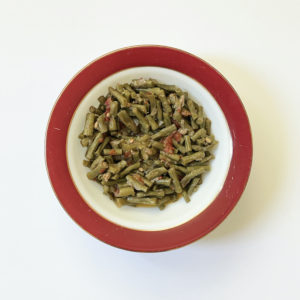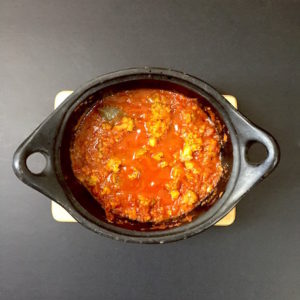Tomato Conserve
Why tomato conserve and not paste? Excellent question.

This comes fromThe Art Of Simple Food II, where Alice Waters explains it is conserve because the result is more jammy than paste-like–at least, I think that’s what she means by “The tomatoes are concentrated into a paste that is more like jam than standard tomato paste.”
What does she mean, anyway? I’m not really sure, but given all Ms. Waters has done for the culinary world and for the IK’s personal edification, we’re not going to quibble. Let’s just move right along.
Ms. Waters has us core, boil, and spin our tomatoes through a food mill (more on this shortly). You’ll find yourself staring at a watery batch of tomato sauce, feeling panicky. Will this vat of red water really cook itself down into paste–sorry–conserve? Seriously? For this you bought new jars in a weirdly small size? Maybe even sprung for a food mill?

Stay the course. While not a set-n-forget recipe, I promise you the tomatoes behave themselves, cooking down with amazing dispatch and smelling quite good in the process. And while time consuming, this isn’t the least bit difficult, asking only for some light stirring.
Admittedly, there is the food mill issue. Alice requests one for this recipe.

My own food mill is a recent and grudging acquisition, purchased because so many recipes I wanted to make required one. Plus it was on sale. Still, I haven’t warmed to the thing. How does it puree/mash/pulverize/strain more effectively than any other kitchen gadget chez IK? And washing it? Don’t get me started. I’d rather tackle the Hall of Mirrors at Versailles with a toothbrush.
Still, tomato skins and seeds must somehow be removed. Tomato skins have a habit of lodging in one’s expensive dental work. As for tomato seeds, cooking embitters them faster than a bad divorce settlement.

Should you share my sentiments about food mills, or don’t have one, you can use a strainer. Yes, strainers are also a hassle to wash, but at least they have no moving parts.
Having leapt that hurdle, we arrive at tomato conserve’s upside: all the joys of preservation sans canner. Meaning canning-phobes may partake of the unique sense of accomplishment gained from gazing at jars filled with one’s own homemade food without laying a fingertip on a canner.
Yeah, yeah, you’re saying. Quit waxing euphoric. What am I gonna do with tomato conserve that I’m not already doing with tomato paste?
 Use your conserve as you would tomato paste. On pizza, in stews and pasta sauces, in soups and chicken dishes. Waters suggests spreading it on garlic toasts. Try a thin layer on a roast beef, chicken, or eggplant sandwich. If you’re the type who gives food as gifts, consider making a “pasta package”: a jar of conserve, a jar of oven dried cherry tomatoes, a package of fresh or homemade pasta, should you make your own. Tuck in some excellent olive oil, a wedge of Parmesan, and you’ve made the right person insanely happy. Or maybe that person is you.
Use your conserve as you would tomato paste. On pizza, in stews and pasta sauces, in soups and chicken dishes. Waters suggests spreading it on garlic toasts. Try a thin layer on a roast beef, chicken, or eggplant sandwich. If you’re the type who gives food as gifts, consider making a “pasta package”: a jar of conserve, a jar of oven dried cherry tomatoes, a package of fresh or homemade pasta, should you make your own. Tuck in some excellent olive oil, a wedge of Parmesan, and you’ve made the right person insanely happy. Or maybe that person is you.
A few notes about preserving food: While surgical sterility isn’t necessary, cleanliness and common sense are important. Wash your hands. Make sure all pots, baking pans, and cutlery are immaculate. Wipe your countertops. Sterilize jars with hot soapy water. Dry by placing them in a warm oven (150-200F) or dishwasher drying cycle. Sterilize lids by washing in hot soapy water. Dry with clean, non-linting dishtowel used for no other purpose. Make sure your tomatoes are clean, too.
White transferring tomato conserve to jars, clean any splashes with a cloth dipped in white vinegar. Do not overfill jars. Four-ounce (1/4 pint jars) are easily found at hardware stores, as are funnels, which make pouring and/or transferring foods an easier, safer job. I recently bought a metal funnel, but plastic ones are just fine.

As this recipe doesn’t use water bath canning or acidulation, you must refrigerate it. Keep unused portions of conserve sealed under a layer of olive oil. Provided conserve is kept under oil, refrigerated, and properly sealed, it should last for months. However, should mold strike, don’t take chances. Throw moldy food out.

Tomato Conserve
adapted from The Art Of Simple Food II by Alice Waters
yield: approximately 4 1/4 pint (4 ounce) jars
preparation time: 4-6 hours, depending on tomatoes
5 pounds ripe tomatoes, preferably organic (see notes about tomato varieties)
2 tablespoons olive oil
1/2 teaspoon salt
Preferred special equipment: A food mill, though a strainer can be used.
Preheat oven to 300 F.
Wash and core the tomatoes. Slice them into large pieces and place in a large pot with olive oil and salt.
Bring tomatoes to a boil, stirring. Turn down to simmer and cook for five minutes, stirring.
Place food mill or strainer over large bowl. Put tomatoes through finest screen of food mill or the strainer. Tomatoes will be very liquid, with a few seeds. That’s okay. Carefully decant into rimmed baking dish and place in oven. I used an 11×13 glass baker. Stir every 30 minutes. Tomato puree will start to cook down rapidly. Stir tomatoes in from edges every half-hour or so.
After about two hours, mixture will have thickened and reduced considerably. From here, watch closely. You may need to transfer the mixture to a smaller pan to avoid burning at edges.
As mixture thickens and gets closer to being done, you will need to gradually decrease oven temperature by 25-degree increments. Test for this by dragging a heat-proof spatula or wooden spoon through the conserve. If it leaves a clear “path” before slowly filling in, it’s time to start turning the temperature down. Another simple way to know is no amount of stirring from the outer edges prevents burning.
What I did:
Hour three of cooking: oven temperature: 250F. Transferred conserve to 9×13 pan
Hour four of cooking: oven temperature: 225F. Transferred conserve to 11×13 baking sheet (thick enough that no “sides” on a pan required)
Hour five of cooking: oven temperature: 200F: conserve ready. Mixture thick, left wide channels that did not close when spatula drawn through it.
Sterilize 5 four-ounce jars (just in case, you will likely use four). Pour mixture in to fill line; don’t overfill. Seal with layer of olive oil. Screw lids on and refrigerate. Top up with olive oil after each use.
Notes: Roma tomatoes are drier and will cook more quickly. They aren’t available in Northern California as I write (early August 2016). Waters notes Romas will taste sweeter, while other varieties of tomato, which have more water, will taste more acidic but still delicious. I used Early Girl, which took 4 1/2 hours total cooking time. They’re wonderful.
Finally, a very happy birthday to Julia Child. If it weren’t for her, America would still be eating green bean casserole.





